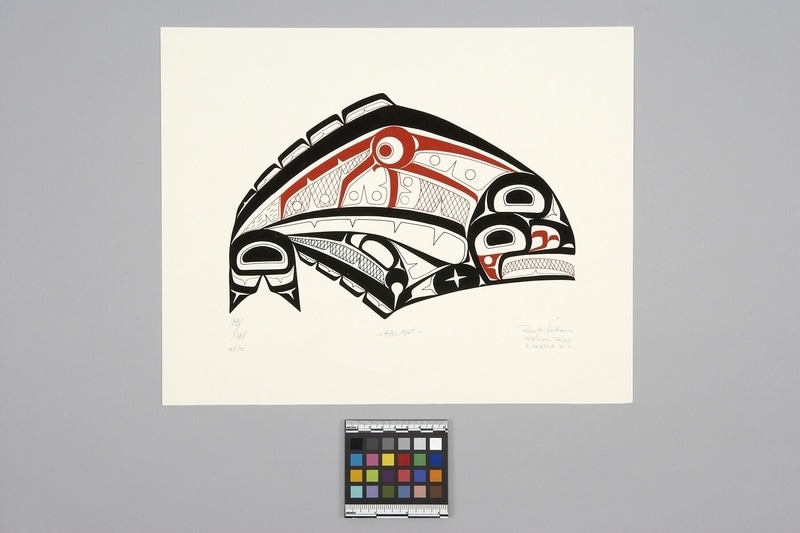Halibut Item Number: Nb7.235 from the MOA: University of British Columbia

Description
Silk-screened red and black halibut with an octopus design. The halibut is in profile and facing to the right side with two black ovoid eyes. The halibut's open mouth has a red tongue with a red split u behind the mouth and red u forms above. There is cross shape behind the mouth with a black split u. The lower half of the halibut has a four-notched black line, black ovoids, and a double-notched split u that has cross hatching within. There are four black split u's along the lower half of the halibut's body. Along the upper half of the halibut's body, there arefour red split u's surrounded by black u forms with a black split u at the end. The tail has a black ovoid, a red split u surrounded by a black u form, and a a black split v. The red octopus is in the upper half of the halibut. The octopus has a circle in a circle eye and five thick tentacles with split u's of various designs within. Pencil inscription across the bottom edge reads '98/195 19/1/76 - HALIBUT - Roy H. Vickers TSIMSIAN TRIBE KITKATLA B.C.'. The print is on a horizontally rectangular, off-white paper piece.
History Of Use
Silk-screen prints are a major form of contemporary Indian art. Silk-screen printing emerged in the 1950's as a new non-traditional art form, and was easily adapted to traditional Northwest Coast two dimensional design concepts. Roy Vickers works in Vancouver and Chilliwack, incorporating traditional Northwest Coast design with a contemporary dimension, often reflecting Christian themes.
Cultural Context
contemporary art
Item History
- Made by Roy Henry Vickers (Maker) in British Columbia, Canada during 1976
- Owned by Roy Henry Vickers before May 6, 1976
- Received from Museum of Anthropology Donations Fund (Funding source) and Roy Henry Vickers (Seller) on May 6, 1976
What
- Name
- Halibut
- Identification Number
- Nb7.235
- Type of Item
- Overall
- height 30.5 cm, width 38.0 cm, depth 0.1 cm
Who
- Culture
- Tsimshian
- Creator
- Roy Henry Vickers (Maker)
- Previous Owner
- Roy Henry Vickers
- Received from
- Museum of Anthropology Donations Fund (Funding source) and Roy Henry Vickers (Seller)
Where
- Holding Institution
- MOA: University of British Columbia
- Made in
- British Columbia, Canada
When
- Creation Date
- during 1976
- Ownership Date
- before May 6, 1976
- Acquisition Date
- on May 6, 1976
Other
- Item Classes
- works on paper
- Condition
- good
- Current Location
- Case 31
- Accession Number
- 0304/0002